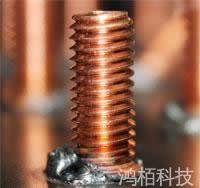The phenomenon that the arc column of the arc deviates from the stud axis is called the arc blow phenomenon.

The picture shows the magnetic blow phenomenon that occurs during short-cycle pulsed arc welding.
When arc blow occurs, one side of the stud will melt intensely, resulting in little or almost no weld on one side of the stud, while the weld on the other side is excessive, accompanied by the generation of pores. It may even cause the stud to be non – vertical, easily burn out the collet, and may also affect the welding strength.
Arc blow mostly occurs during long – cycle drawn arc stud welding. It hardly occurs in energy – storage stud welding and rarely occurs in short – cycle drawn arc stud welding. The longer the welding time, the greater the possibility of arc blow.
The following reasons may cause arc blow:
· Influence of stud material (low – carbon steel material is prone to cause arc blow).
· Magnetic field interference (so it is also called “magnetic blow”).
· Interference from surrounding current – carrying equipment (such as the interference generated when the welding machine is working).
· Influence of the shape of the workpiece itself.
· Welding at the edge of the workpiece.
· During long – cycle gas – shielded welding.
· When the stud diameter is relatively large.
Arc blow is generally caused by external factors and has nothing to do with the quality of the welding machine itself.





